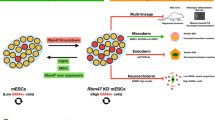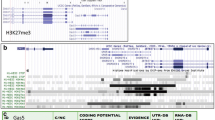Abstract:
Embryonic stem cells (ES cells) are pluripotent cells capable for self-renewal and to differentiate to all cell types. Finding the molecular mechanisms responsible for these unique characteristics of ES cells is important. RNA-binding proteins play important roles in post-transcriptional gene regulation by binding to specific mRNA targets. In this study, we investigated the targets of RNA-binding protein Rbm47 in mouse ES cells. Overexpression of HA epitope-tagged Rbm47 in mouse ES cells followed by RNA-binding protein immunoprecipitation, and then RT-PCR analysis of co-immunoprecipitated RNA showed that Rbm47 binds to Nanog transcript in mouse ES cells and doesn’t bind to Sox2 and Oct4 transcripts in these cells. This finding can give rise to reveal molecular mechanisms underlying pluripotency and stemness of ES cells and will be necessary for efficient application of these cells in regenerative medicine and tissue engineering.





Similar content being viewed by others
References
Kolios G, Moodley Y (2013) Introduction to stem cells and regenerative medicine. Respiration 85:3–10
Ilic D, Polak JM (2011) Stem cells in regenerative medicine: introduction. Br Med Bull 98:117–126
Barker RA (2012) Stem cells and neurodegenerative diseases: Where is it all going? Regen Med 7:26–31
Yokote S, Yokoo T (2012) Stem cells in kidney regeneration. Curr Med Chem 19:6009–6017
Abdelwahid E, Siminiak T, Guarita-Souza LC, Teixeira de Carvalho KA, Gallo P et al (2011) Stem cell therapy in heart diseases: a review of selected new perspectives, practical considerations and clinical applications. Curr Cardiol Rev 7:201–212
Yeo JC, Ng HH (2012) The transcriptional regulation of pluripotency. Cell Res 23:20–32
Heinrich EM, Dimmeler S (2012) MicroRNAs and stem cells: control of pluripotency, reprogramming, and lineage commitment. Circ Res 110:1014–1022
Huo JS, Zambidis ET (2012) Pivots of pluripotency: the roles of non-coding RNA in regulating embryonic and induced pluripotent stem cells. Biochim Biophys Acta 1830:2385–2394
Chen X, Vega VB, Ng HH (2008) Transcriptional regulatory networks in embryonic stem cells. Cold Spring Harb Symp Quant Biol 73:203–209
Orkin SH, Wang J, Kim J, Chu J, Rao S et al (2008) The transcriptional network controlling pluripotency in ES cells. Cold Spring Harb Symp Quant Biol 73:195–202
Orphanides G, Reinberg D (2002) A unified theory of gene expression. Cell 108:439–451
Sanchez-Diaz P, Penalva LO (2006) Post-transcription meets post-genomic: the saga of RNA binding proteins in a new era. RNA Biol 3:101–109
Tenenbaum SA, Christiansen J, Nielsen H (2011) The post-transcriptional operon. Methods Mol Biol 703:237–245
Hogan DJ, Riordan DP, Gerber AP, Herschlag D, Brown PO (2008) Diverse RNA-binding proteins interact with functionally related sets of RNAs, suggesting an extensive regulatory system. PLoS Biol 6:e255
Janga SC, Mittal N (2011) Construction, structure and dynamics of post-transcriptional regulatory network directed by RNA-binding proteins. Adv Exp Med Biol 722:103–117
Tenenbaum SA, Lager PJ, Carson CC, Keene JD (2002) Ribonomics: identifying mRNA subsets in mRNP complexes using antibodies to RNA-binding proteins and genomic arrays. Methods 26:191–198
Penalva LO, Tenenbaum SA, Keene JD (2004) Gene expression analysis of messenger RNP complexes. Methods Mol Biol 257:125–134
Milek M, Wyler E, Landthaler M (2012) Transcriptome-wide analysis of protein–RNA interactions using high-throughput sequencing. Semin Cell Dev Biol 23:206–212
Zhao J, Ohsumi TK, Kung JT, Ogawa Y, Grau DJ et al (2010) Genome-wide identification of polycomb-associated RNAs by RIP-seq. Mol Cell 40:939–953
Keene JD, Komisarow JM, Friedersdorf MB (2006) RIP-Chip: the isolation and identification of mRNAs, microRNAs and protein components of ribonucleoprotein complexes from cell extracts. Nat Protoc 1:302–307
Zhu R, Iacovino M, Mahen E, Kyba M, Matin A (2011) Transcripts that associate with the RNA binding protein, DEAD-END (DND1), in embryonic stem (ES) cells. BMC Mol Biol 12:37
Darnell RB (2010) HITS-CLIP: panoramic views of protein-RNA regulation in living cells. Wiley Interdiscip Rev RNA 1:266–286
Ascano M, Hafner M, Cekan P, Gerstberger S, Tuschl T (2012) Identification of RNA–protein interaction networks using PAR-CLIP. Wiley Interdiscip Rev RNA 3:159–177
Niranjanakumari S, Lasda E, Brazas R, Garcia-Blanco MA (2002) Reversible cross-linking combined with immunoprecipitation to study RNA–protein interactions in vivo. Methods 26:182–190
Mitsui K, Tokuzawa Y, Itoh H, Segawa K, Murakami M et al (2003) The homeoprotein Nanog is required for maintenance of pluripotency in mouse epiblast and ES cells. Cell 113:631–642
Legendre JB, Campbell ZT, Kroll-Conner P, Anderson P, Kimble J et al (2012) RNA targets and specificity of Staufen, a double-stranded RNA-binding protein in C. elegans. J Biol Chem 288:2532–2545
Mitchell SF, Jain S, She M, Parker R (2012) Global analysis of yeast mRNPs. Nat Struct Mol Biol 20:127–133
Sephton CF, Cenik C, Kucukural A, Dammer EB, Cenik B et al (2011) Identification of neuronal RNA targets of TDP-43-containing ribonucleoprotein complexes. J Biol Chem 286:1204–1215
Narva E, Rahkonen N, Emani MR, Lund R, Pursiheimo JP et al (2012) RNA-binding protein L1TD1 interacts with LIN28 via RNA and is required for human embryonic stem cell self-renewal and cancer cell proliferation. Stem Cells 30:452–460
Elatmani H, Dormoy-Raclet V, Dubus P, Dautry F, Chazaud C et al (2011) The RNA-binding protein Unr prevents mouse embryonic stem cells differentiation toward the primitive endoderm lineage. Stem Cells 29:1504–1516
Wuebben EL, Mallanna SK, Cox JL, Rizzino A (2012) Musashi2 is required for the self-renewal and pluripotency of embryonic stem cells. PLoS ONE 7:e34827
Park JM, Kohn MJ, Bruinsma MW, Vech C, Intine RV et al (2006) The multifunctional RNA-binding protein La is required for mouse development and for the establishment of embryonic stem cells. Mol Cell Biol 26:1445–1451
Hong IS, Kang KS (2013) The effects of hedgehog on the RNA-binding protein Msi1 in the proliferation and apoptosis of mesenchymal stem cells. PLoS ONE 8:e56496
Niu C, Zhang J, Breslin P, Onciu M, Ma Z et al (2009) c-Myc is a target of RNA-binding motif protein 15 in the regulation of adult hematopoietic stem cell and megakaryocyte development. Blood 114:2087–2096
Salton M, Elkon R, Borodina T, Davydov A, Yaspo ML et al (2011) Matrin 3 binds and stabilizes mRNA. PLoS ONE 6:e23882
Calaluce R, Gubin MM, Davis JW, Magee JD, Chen J et al (2010) The RNA binding protein HuR differentially regulates unique subsets of mRNAs in estrogen receptor negative and estrogen receptor positive breast cancer. BMC Cancer 10:126
Ule J, Jensen K, Mele A, Darnell RB (2005) CLIP: a method for identifying protein–RNA interaction sites in living cells. Methods 37:376–386
Konig J, Zarnack K, Rot G, Curk T, Kayikci M et al (2011) iCLIP—transcriptome-wide mapping of protein–RNA interactions with individual nucleotide resolution. J Vis Exp 50:e2638
Ule J, Jensen KB, Ruggiu M, Mele A, Ule A et al (2003) CLIP identifies Nova-regulated RNA networks in the brain. Science 302:1212–1215
Iruarrizaga-Lejarreta M, Varela-Rey M, Lozano JJ, Fernandez-Ramos D, Rodriguez-Ezpeleta N et al (2012) The RNA-binding protein human antigen R controls global changes in gene expression during Schwann cell development. J Neurosci 32:4944–4958
Apponi LH, Corbett AH, Pavlath GK (2011) RNA-binding proteins and gene regulation in myogenesis. Trends Pharmacol Sci 32:652–658
Cilley CD, Williamson JR (1999) PACE analysis of RNA–peptide interactions. Methods Mol Biol 118:129–141
Gao FB, Carson CC, Levine T, Keene JD (1994) Selection of a subset of mRNAs from combinatorial 3′ untranslated region libraries using neuronal RNA-binding protein Hel-N1. Proc Natl Acad Sci USA 91:11207–11211
SenGupta DJ, Zhang B, Kraemer B, Pochart P, Fields S et al (1996) A three-hybrid system to detect RNA–protein interactions in vivo. Proc Natl Acad Sci USA 93:8496–8501
Bernstein DS, Buter N, Stumpf C, Wickens M (2002) Analyzing mRNA–protein complexes using a yeast three-hybrid system. Methods 26:123–141
Tenenbaum SA, Carson CC, Lager PJ, Keene JD (2000) Identifying mRNA subsets in messenger ribonucleoprotein complexes by using cDNA arrays. Proc Natl Acad Sci USA 97:14085–14090
Tenenbaum SA, Carson CC, Atasoy U, Keene JD (2003) Genome-wide regulatory analysis using en masse nuclear run-ons and ribonomic profiling with autoimmune sera. Gene 317:79–87
Eystathioy T, Chan EK, Tenenbaum SA, Keene JD, Griffith K et al (2002) A phosphorylated cytoplasmic autoantigen, GW182, associates with a unique population of human mRNAs within novel cytoplasmic speckles. Mol Biol Cell 13:1338–1351
Kaneko S, Manley JL (2005) The mammalian RNA polymerase II C-terminal domain interacts with RNA to suppress transcription-coupled 3′ end formation. Mol Cell 20:91–103
Kim KK, Kim YC, Adelstein RS, Kawamoto S (2011) Fox-3 and PSF interact to activate neural cell-specific alternative splicing. Nucleic Acids Res 39:3064–3078
Liao TL, Wu CY, Su WC, Jeng KS, Lai MM (2010) Ubiquitination and deubiquitination of NP protein regulates influenza A virus RNA replication. EMBO J 29:3879–3890
Danilin S, Sourbier C, Thomas L, Lindner V, Rothhut S et al (2010) Role of the RNA-binding protein HuR in human renal cell carcinoma. Carcinogenesis 31:1018–1026
Anko ML, Morales L, Henry I, Beyer A, Neugebauer KM (2010) Global analysis reveals SRp20- and SRp75-specific mRNPs in cycling and neural cells. Nat Struct Mol Biol 17:962–970
Author information
Authors and Affiliations
Corresponding author
Rights and permissions
About this article
Cite this article
Yeganeh, M., Seyedjafari, E., Kamrani, F.A. et al. RNA-binding protein Rbm47 binds to Nanog in mouse embryonic stem cells. Mol Biol Rep 40, 4391–4396 (2013). https://doi.org/10.1007/s11033-013-2528-0
Received:
Accepted:
Published:
Issue Date:
DOI: https://doi.org/10.1007/s11033-013-2528-0




